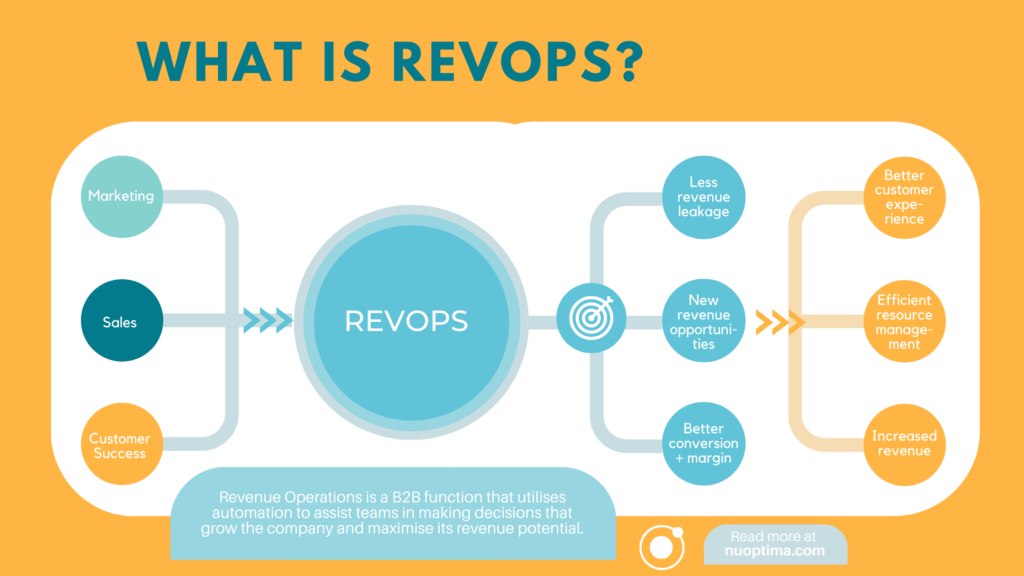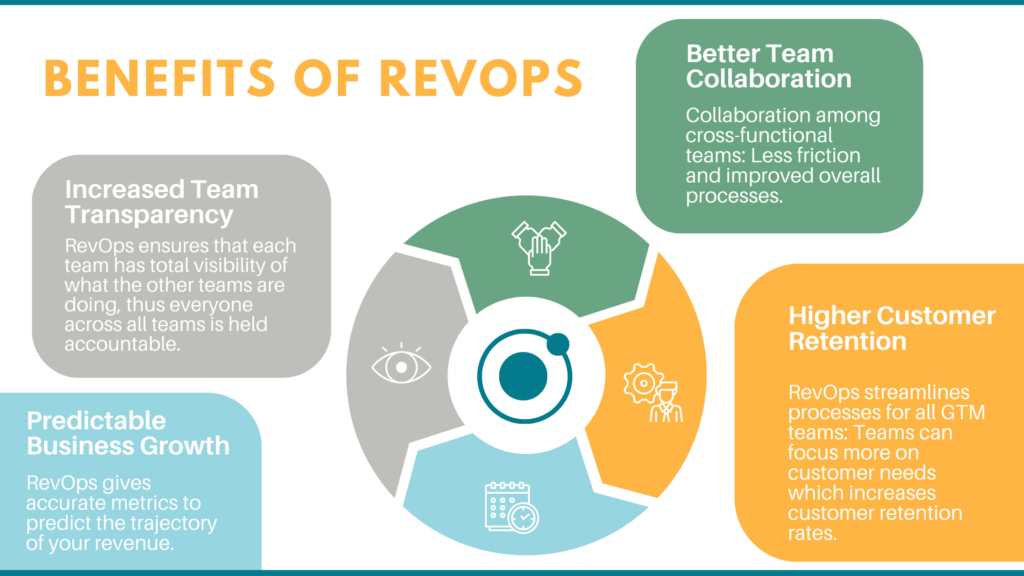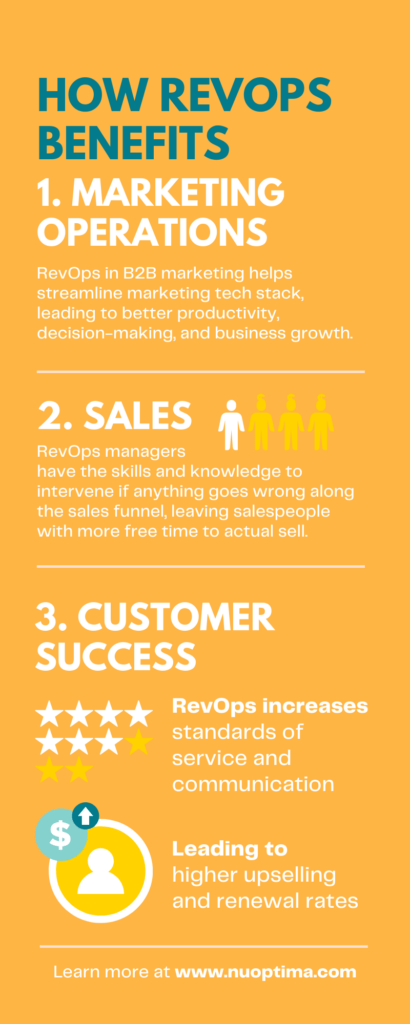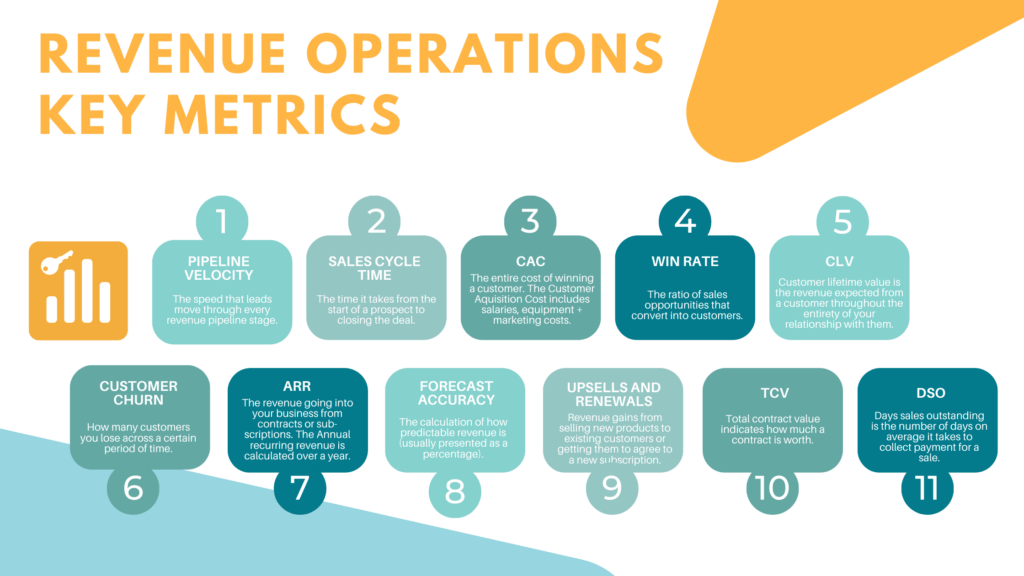Read NUOPTIMA’s complete overview on RevOps and book a free 15-minute discovery call with our experts if you wish to use SEO services to further your business.
Key Points
- RevOps is a B2B business function with the aim of maximising the revenue potential of an organisation.
- Benefits of RevOps include better team collaboration, higher customer retention, predictable business growth, and increased team transparency.
- If you struggle to manage with numerous tools, there is a lack of coordination between your teams, or your processes are flawed, you should incorporate RevOps into your business.
- If you’re interested to learn more about NUOPTIMA’s RevOps services for your company, schedule a 15-minute discovery call with one of our experts today.
What is RevOps?
RevOps — which stands for ‘revenue operations’ — is a B2B function that utilises automation to assist teams in making decisions that grow the company. It is a business function that aims to maximise the revenue potential of an organisation.
Traditionally, every division within a business has its own independent operations team and each of these reports to the functions they serve. For instance, Marketing Operations owns all marketing systems and reports to the Head of Marketing. And Sales Operations owns all sales systems and reports therefore to the Head of Sales. With this traditional strategy, the priorities of each team are set by their respective leader. And while this generally works, it does not always. The downside to this is that each function is isolated or siloed, leaving the organisation disjointed. Each operations specialist will inevitably have varying priorities, incentives, and goals. As a result, coordination can become a big challenge when operations teams are not all perfectly aligned. RevOps was developed to offer a solution to this problem.

So, how does RevOps resolve this exactly? RevOps is a centralised function that amalgamates these traditionally isolated operations teams. RevOps is a single team that serves all revenue-generating business units, such as Marketing Operations, Sales Operations, and Customer Success Operations. It brings everyone together around three shared goals: reduce revenue leakage, utilise customer data to find new revenue opportunities, and price for better conversion and margin. RevOps ensures uniformity and accountability in operations between marketing, sales, and customer service. This leads to enhanced customer experience, better management of resources, and increased revenue for the company.
What is the Difference Between RevOps and Sales Operations?
The primary difference between RevOps and Sales operations is that while the latter supports the sales team with sales opportunities and all other facets of sales exclusively, RevOps is responsible for operations across all sales, marketing, and customer success teams. A simple way of looking at it is that if the object of sales is to allow the sales team to spend more time selling by reducing friction points, RevOps looks at revenue generation as a whole. Sales Ops is only one piece of the puzzle, whereas RevOps considers the puzzle as a whole. RevOps does everything that sales ops do, but they also do it for marketing, customer success, and systems while keeping these teams aligned. While sales ops are designed to assist the sales team, RevOps is intended to make the entire revenue-generating side of the business more efficient and effective.
Benefits of RevOps
There are numerous advantages to adopting RevOps in a business. Here are a few key benefits.

Better Team Collaboration
RevOps allows collaboration among cross-functional teams. This is a benefit because when teams work together towards a unified goal, less time is spent on infighting, and more time is spent on actually achieving these goals. This, therefore, means a decrease in friction and an improvement to the overall process.
Higher Retention of Customers
RevOps streamlines processes for all Go-To-Market (GTM) teams. This means they can be more attentive to the needs of customers. Consequently, this organically boosts the customer experience and leads to higher customer retention rates. By integrating a comprehensive GTM strategy, businesses can ensure that their customer-facing teams are aligned and working towards common goals, further enhancing customer satisfaction and retention.
Business Growth that is Predictable
Businesses are focusing on revenue growth predictions more and more, and these predictions are critical in planning a streamlined strategy for revenue generation. From investing in new markets to enterprise search marketing, each strategy can be prepared and tested to see if it works. RevOps gives accurate metrics to predict the trajectory of your revenue (more on key metrics later on in this article).
Increased Team Transparency
A significant issue in cross-team meetings is a lack of alignment. For instance, the marketing team could talk about SEO (search engine optimisation), the paid media team could talk about conversion rates, and the sales team could talk about closing rates. While all these teams are working toward a common purpose, there is an evident lack of alignment. This means it is difficult for them to be aware of what the other is doing, leading to friction and conflict.
RevOps, however, ensures each team has total visibility of what the other teams are doing by creating alignment in every handoff point. This means that everyone across all teams is held accountable. And better accountability causes better transparency.
How RevOps Benefits Different Revenue-Generating Areas

An efficiently run RevOps team assists each revenue-generating area of an organisation to ensure sustainable growth.
Marketing Operations
Marketing teams usually work with more technology and data than other revenue-generating departments. Therefore the main focus for a RevOps manager in B2B marketing is to streamline the marketing tech stack. This empowers marketers to access increased data from the other teams (as well as the other way around). This leads to better productivity, decision-making, and business growth.
Sales Operations
A RevOps manager will understand what is going on at all stages of the sales funnel, so if anything were to go awry, they have both the skills and knowledge to quickly fix it. This means that salespeople can therefore spend more time focusing on what they do best, such as engaging with prospects and closing fresh business.
Customer Success
When previously isolated departments are working together, they are more attentive to the needs of their customers. Customers will notice an increase in standards of service and communication, making life easier for customer success teams as they will see the refreshing difference in their upselling and renewal rates.
The Three Pillars of RevOps
RevOps is founded around three pillars. Each pillar is a foundation upon which the next pillar is built. Only when you have each pillar properly defined can you achieve clarity, focus, and accountability through your company or organisation. Let’s consider each of these pillars.
- Pillar One – Process: The right processes must be in place to create a collaborative culture. RevOps activates uniform processes to nurture both trust and accountability within your organisation. As the teams work together, you will start to see further benefits such as improved retention, shorter sales cycles, and an increase in upsells.
- Pillar Two – Platform: Having the correct information is vital to success. Therefore, within your organisation, you must both connect and align your technology to give a clear, accurate story around your revenue stream. By having a single source of truth, individuals can determine how they (both directly and indirectly) affect the pipeline. Plus, teams can also assess fast if their activities influence corporate objectives.
- Pillar Three – People: The last pillar is the people who are responsible for bringing together and managing both your process and platform. Depending on the size of an organisation, RevOps creates a specific RevOps team or distributes the responsibilities of RevOps among already existing team members.
Why Is RevOps Booming?
The traditional approach of siloed operations teams does not work anymore, so businesses are beginning to embrace RevOps. Two trends are making the old style of operations obsolete:
- The sales and marketing funnel is changing.
- Teams now share tools and data sources.
The segregated sales and marketing funnel has been replaced by a funnel where every client-facing team has responsibility throughout said funnel. Client-facing teams now work together like never before. Below are a few examples of this change:
- Sales Development Representatives (SDR): Historically, the sales development function belonged to the sales team exclusively, but in recent years, this has changed. Far fewer SDR teams report to sales.
- Chief Revenue Officer (CRO): This new title only began appearing in recent years. It reflects the pressure that companies feel in taking a holistic approach to generating revenue.
- Tools: Tools are shared between teams more than they have been before. Examples of these tools that service multiple client-facing teams include 6Sense[1] and Outreach[2].
RevOps Key Metrics
Revenue operations is a numbers game, so below are some metrics you need to know in a revenue operations analyst job:

- Pipeline velocity: the speed that leads move through every revenue pipeline stage.
- Sales cycle time: the time it takes from the start of a prospect to closing the deal.
- Customer acquisition cost (CAC): the entire cost of winning a customer, including salaries, equipment, and marketing costs.
- Win rate: the ratio of sales opportunities that convert into customers.
- Customer lifetime value (CLV): the revenue amount you can expect from a customer throughout the entirety of your relationship with them.
- Customer churn: how many customers you lose across a certain period of time.
- Annual recurring revenue (ARR): the revenue going into your business from contracts or subscriptions (calculated over a year).
- Forecast accuracy: the calculation of how predictable revenue is (usually presented as a percentage).
- Upsells and renewals: how much revenue you make from selling new products to existing customers or getting them to agree to a new subscription or contract.
- Total contract value (TCV): how much a contract is worth.
- Days sales outstanding (DSO): the number of days on average it takes to collect payment for a sale.
How Do You Know If You Need RevOps?
If you struggle to manage with numerous tools, there is a lack of coordination between your teams, or your processes are flawed, you need to incorporate RevOps into your business. While every team in an organisation traditionally has its own tech and tool suite or particular functionalities, the isolated team structure can lead to tool overlap, driving up expenditure and negatively affecting your tech inventory. RevOps confronts this issue by integrating the purchase, implementation, and management of tech. Today, business processes need to be updated regularly, and RevOps includes all teams in new process creation, so everyone is on the same page, leading to more conversions.
Naturally, disjointed teams constitute a significant disadvantage to a smooth revenue generation process. RevOps creates one team from small independent units and counters department isolation and conflicts.
How to Implement RevOps
B2B organisations that implement aligned RevOps are believed to be best positioned to thrive in the next three to five years. There are four main phases for implementing RevOps into your business.
Phase One: Audit
This first phase requires auditing your customer’s individual journey and discovering the major pain points between various departments. This can be done by thoroughly auditing:
- Your website to make sure there are conversion best practices in operation.
- The existing tech in your marketing, sales, and customer success teams to make sure they are tracking customer movement and traffic correctly.
- Your existing content so you can then try to align it with your customer lifecycle (and fill in any gaps).
Phase Two: Align
- Utilise Google Analytics[3] to ensure you have an accurate picture of your revenue funnel. Also, review your overall business health.
- Provide streamlined RevOps processes to your team for content marketing, all inbound and outbound sales, and customer service.
- Audit all software to check if there are tech overlaps.

Phase Three: Build
- Build a map for GTM teams for onboarding and customer acquisition.
- Build task queues for both inbound and outbound sales (including follow-up emails).
- Build a dedicated RevOps dashboard to present all pain points and blocks.
Phase Four: Optimise
- Organise a regular RevOps meeting schedule with the various heads of sales, marketing, and customer service. This is so everyone is aligned with the unified revenue generation process.
- Determine which function faces the largest bottleneck each month, then use preset playbook guides to address these issues.
- Set up a 12-month execution plan for the continued adoption of your RevOps strategy.
Final Thoughts
RevOps is defined as a B2B business function with the intention of maximising the revenue potential of an organisation. RevOps holds many benefits, including better team collaboration, higher customer retention, predictable business growth, and increased team transparency. If you struggle to manage with numerous tools, there is a distinct lack of coordination between your teams, or your processes are flawed, you should incorporate RevOps into your company. If you want to know more about RevOps services offered by NUOPTIMA, book a 15-minute discovery call with a member of our team now.



